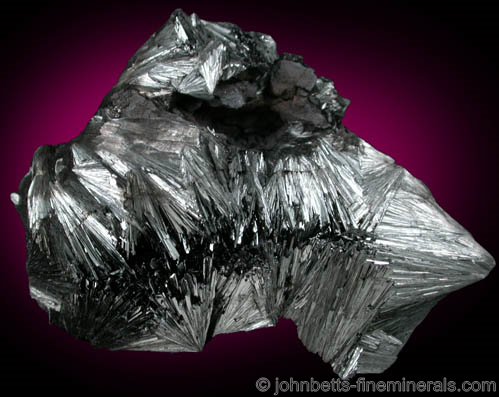The Mineral pyrolusite

Pyrolusite is the most common manganese mineral. It is one of several manganese oxide minerals, which are all dark gray to black in color and may be very difficult to distinguish from one another, especially when in
massive form.
Wad is a term used to describe a combination of several unidentified manganese oxides, which may include a combination of Pyrolusite,
Manganite,
Psilomelane, and
Romanechite.
Pyrolusite is known for its finely fibrous
acicular crystal habits. These forms are usually sooty and will likely smudge the hands when touched.
Pyrolusite is named from a combination of the Greek words "Pyr" - fire, and "Louein" - to wash, since this mineral was once used as an agent to remove green and brown tints during the manufacture of glass.
Color
Dark gray to black, sometimes with a bluish tint
Crystal System
Tetragonal
Properties
Streak
Bluish black to black |
Hardness
6 - 6.5 |
Transparency
Opaque |
Specific Gravity
4.4 - 5 |
Luster
Metallic, dull |
Cleavage
1,1 |
Fracture
Splintery, uneven |
Tenacity
Brittle |
Other ID Marks
Leaves black powdery residue upon contact with surfaces. |
Crystal Habits
Individual crystals are rare, and when they do occur, they are in thin, sharp crystals with steep triangular edges or rectangular blocky crystals. Crystals are usually deeply striated or etched in parallel lines. Large crystals are more often pseudomorphs of Pyrolusite after Manganite. More commonly in finely packed fibrous, acicular and radial forms composed of very fine needles or fibers. Also in intersecting radiating veins, in bladed groups, reniform, botryoidal, [statalctitic%] grainy, massive, concretionary, and earthy.
Varieties
-
Uncommon form of Pyrolusite that has larger, individual crystals.
Uses
Pyrolusite is one of the most important ores of manganese. It is also a component of the production of steel, and was once used for the manufacture of batteries. It is also used in the preparation of chlorine, and as an agent in coloring and dyes.
Noteworthy Localities
Pyrolusite is a very common mineral worldwide. However, most forms are in uninteresting massive and earthy habit. Only localities that produced specimens worthy of collections are mentioned here.
Some of the best Pyrolusite specimens have come from the Imini mine, Ouarzazate Province, Morocco, in the form of lustrous crystal sprays. Many localities in Germany produce good examples of Pyrolusite. Especially noteworthy are are Ilfeld, Nordhausen, Harz Mountains, Thuringia; and Gremmelsbach, Triberg, Black Forest, Baden-Württemberg. Micro crystal tufts come from the Clara Mine, Oberwolfach, Black Forest, Baden-Württemberg.
Rounded crystal groups and
bladed aggregates of Pyrolusite have come from Cartagena Mountains, Murcia, Spain; and sharp crystal sprays from Serra da Mina Mine, Cercal, Setúbal District, Portugal. Relatively large crystals of Pyrolusite came from the Iron Monarch Quarry, Iron Knob, South Australia. Most crystallized Pyrolusite from this locality is actually a
pseudomorph after
Manganite.
In the U.S., an unusual type of Pyrolusite in groupings of uniquely large crystals is known from Las Cruces, Doña Ana Co., New Mexico. Other important U.S. localities include the Taylor Mine, Alberta, Baraga Co., Michigan; and Negaunee, Marquette Co., Michigan.
Distingushing Similar Minerals
Psilomelane, Romanechite and other manganese oxides - May be very difficult to distinguish, although they don't often form in the lustrous compact crystal groups as Pyrolusite.
Manganite - Does not powder the finger upon contact.
Goethite - Usually has a duller luster, doesn't smudge the hands.